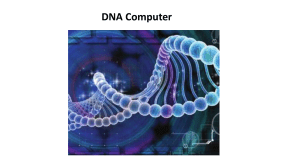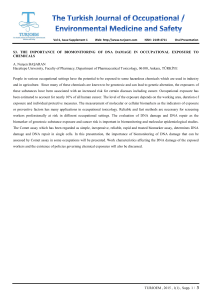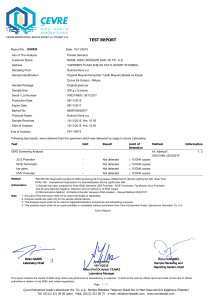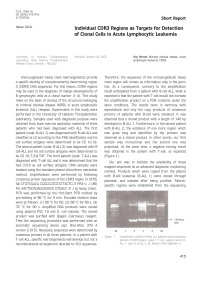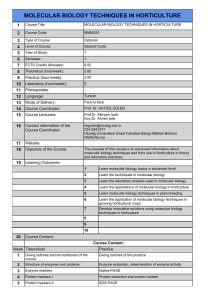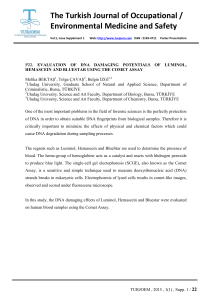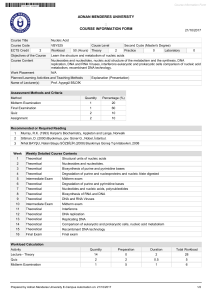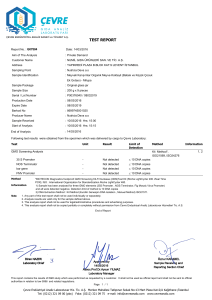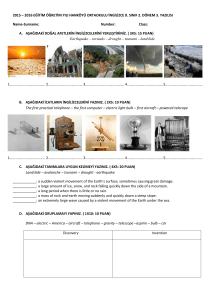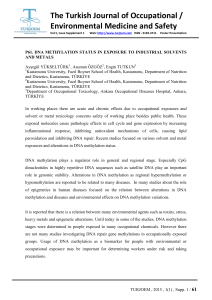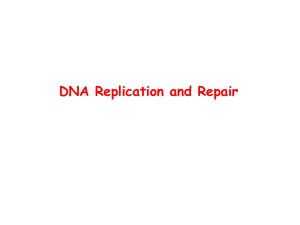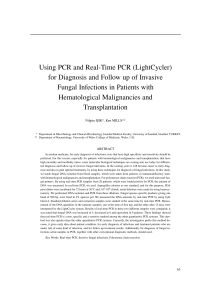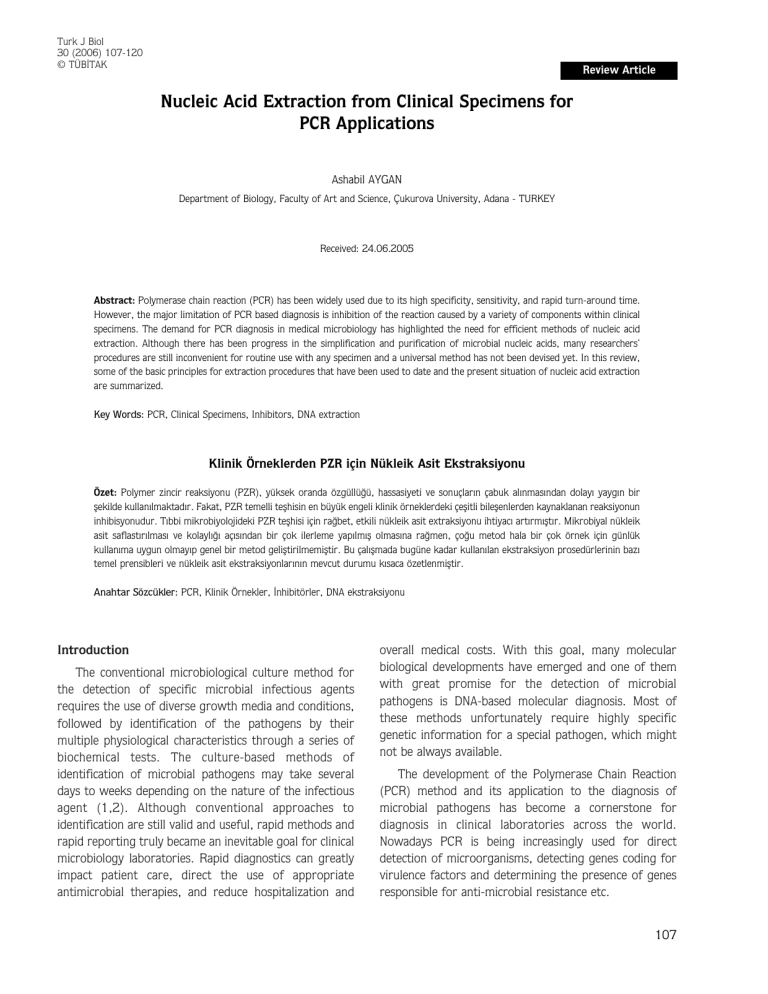
Turk J Biol
30 (2006) 107-120
© TÜB‹TAK
Review Article
Nucleic Acid Extraction from Clinical Specimens for
PCR Applications
Ashabil AYGAN
Department of Biology, Faculty of Art and Science, Çukurova University, Adana - TURKEY
Received: 24.06.2005
Abstract: Polymerase chain reaction (PCR) has been widely used due to its high specificity, sensitivity, and rapid turn-around time.
However, the major limitation of PCR based diagnosis is inhibition of the reaction caused by a variety of components within clinical
specimens. The demand for PCR diagnosis in medical microbiology has highlighted the need for efficient methods of nucleic acid
extraction. Although there has been progress in the simplification and purification of microbial nucleic acids, many researchers’
procedures are still inconvenient for routine use with any specimen and a universal method has not been devised yet. In this review,
some of the basic principles for extraction procedures that have been used to date and the present situation of nucleic acid extraction
are summarized.
Key Words: PCR, Clinical Specimens, Inhibitors, DNA extraction
Klinik Örneklerden PZR için Nükleik Asit Ekstraksiyonu
Özet: Polymer zincir reaksiyonu (PZR), yüksek oranda özgüllü¤ü, hassasiyeti ve sonuçlar›n çabuk al›nmas›ndan dolay› yayg›n bir
flekilde kullan›lmaktad›r. Fakat, PZR temelli teflhisin en büyük engeli klinik örneklerdeki çeflitli bileflenlerden kaynaklanan reaksiyonun
inhibisyonudur. T›bbi mikrobiyolojideki PZR teflhisi için ra¤bet, etkili nükleik asit extraksiyonu ihtiyac› art›rm›flt›r. Mikrobiyal nükleik
asit saflast›r›lmas› ve kolayl›¤› aç›s›ndan bir çok ilerleme yap›lm›fl olmas›na ra¤men, ço¤u metod hala bir çok örnek için günlük
kullan›ma uygun olmay›p genel bir metod gelifltirilmemifltir. Bu çal›flmada bugüne kadar kullan›lan ekstraksiyon prosedürlerinin baz›
temel prensibleri ve nükleik asit ekstraksiyonlar›n›n mevcut durumu k›saca özetlenmifltir.
Anahtar Sözcükler: PCR, Klinik Örnekler, ‹nhibitörler, DNA ekstraksiyonu
Introduction
The conventional microbiological culture method for
the detection of specific microbial infectious agents
requires the use of diverse growth media and conditions,
followed by identification of the pathogens by their
multiple physiological characteristics through a series of
biochemical tests. The culture-based methods of
identification of microbial pathogens may take several
days to weeks depending on the nature of the infectious
agent (1,2). Although conventional approaches to
identification are still valid and useful, rapid methods and
rapid reporting truly became an inevitable goal for clinical
microbiology laboratories. Rapid diagnostics can greatly
impact patient care, direct the use of appropriate
antimicrobial therapies, and reduce hospitalization and
overall medical costs. With this goal, many molecular
biological developments have emerged and one of them
with great promise for the detection of microbial
pathogens is DNA-based molecular diagnosis. Most of
these methods unfortunately require highly specific
genetic information for a special pathogen, which might
not be always available.
The development of the Polymerase Chain Reaction
(PCR) method and its application to the diagnosis of
microbial pathogens has become a cornerstone for
diagnosis in clinical laboratories across the world.
Nowadays PCR is being increasingly used for direct
detection of microorganisms, detecting genes coding for
virulence factors and determining the presence of genes
responsible for anti-microbial resistance etc.
107
Nucleic Acid Extraction from Clinical Specimens for PCR Applications
However, the major limitation of PCR based diagnosis
is inhibition of the reaction caused by a variety of
components within the clinical specimens. Several
extraction methods have been developed and used by
investigators from clinical samples prior to performing
PCR to avoid inhibition, because of the varied specimens
such as blood, urine, sputum, and CSF. Therefore, this
short review discusses the preparation of clinical samples,
mainly blood and CSF, prior to PCR application.
Rapid Identification of Pathogenic Microorganisms
Rapid methods have not only decreased the turnaround time for patient results, but have also increased
the clinical relevance of the information provided by the
laboratory.
One of the rapid methods for identification of a
microorganism is to use gas chromatography, which can
detect specific bacterial products directly in clinical
specimens. Brooks and associates have detected various
organism-specific products in extracts of several
biological fluids (3-5).
Immunological methods have also found a place in the
diagnosis of certain infections as one of the rapid
methods. Although those methods have been used for
detection of antigens in body fluids, Countercurrent
Immuno-Electrophoresis (CIE), which uses an electric
current to speed up the migration of the antigen and
antibody, was the only one to be accepted in clinical
practice. However, even this method has been largely
supplanted by the more rapid latex particle agglutination.
As the Radio Immuno-Assay (RIA) has no impact on
routine applications, testing for markers for Hepatitis B
infection is still done by RIA, but has mostly been now
replaced by the Enzyme Immune Assay Method (EIA) (6).
Until late 1988, most of the molecular based clinical
diagnostic methods were limited to Southern Blot analysis
of DNA and Northern Blot analysis of RNA. Both methods
are limited by the large number amount of DNA or RNA
required and at least one to several thousand cells had to
be present in the sample to show a detectable amount of
signal.
Drawbacks of the methods
The culture-based methods are very laborious and
take time. Moreover, some microorganisms require
culturing in animals, which takes a considerable amount
of time and effort.
108
In the case of bacteremia, the blood cultures’
sensitivity may be limited because patients may not be
bacteremic at the time that the blood is drawn for culture
(7). Furthermore, a substantial number of cases of
bacteremia in children may be missed by the performance
of a single blood culture (8) because of low density and
the fastidious nature of the pathogen. Additionally, some
organisms are cell dependent such as Coxiella burnetii,
Bartonella spp. and Chlamydia spp. and detection of fungi
is still difficult even with improved automated blood
culture methods and materials (9). In the case of
Methicillin Resistant Staphylococcus aureus (MRSA),
which is one of the most common causes of nosocomial
infection, standard bacterial identification susceptibility
testing frequently require as long as 72 h to report
results, and there may be difficulty in rapidly and
accurately identifying Methicillin Resistant Coagulase
Negative (MRCoNSA) (10). The diagnosis of Listeria
meningitis, meningoencephalitis, or septicemia is based
on the culture of cerebrospinal fluid (CSF) and blood. The
direct examination of Gram stained clinical specimen is
generally of little value, because L. monocytogenes is
often present in some samples, particularly in CSF (11).
Another complication is that many patients are pretreated
with antibiotics before their blood is cultured. The culture
method may be negative if the patients have received
antibiotics before blood was taken. It is possible to
enlarge the list of such obstructions.
Although RIA has great sensitivity and specificity the
problems associated with radioactive waste disposal and
the instability of certain radionuclides is limiting the
techniques. The amount of antigen are generally present
during the acute phase of the illness; thus the sensitivity
of EIA may be compromised by trapping of antigen in the
specimen and the affinity of antigens for antibodies
produced.
Alternate methods with poly or monoclonal antibody
can show cross-reactivity with other related pathogens.
Antigen molecules with only a single epitope are rarely
encountered; rather, hundreds or even thousands of
potential antigenic determinants may exist on a cell
surface. Cross-reactivity occurs because of shared
antigenic determinants or because of mutations resulting
in the evolution of epitopes. Therefore the interpretation
of positive results may be difficult and require expert
judgment.
A. AYGAN
RIA is principally similar to ELISA, but the antigens in
ELISA are bound to the antibodies that are conjugated
with enzymes. Although RIA is more sensitive than ELISA,
ELISA is preferred due to the problems caused by the
radioactive isotopes used in RIA.
Nucleic Acid Probe Technology
A nucleic acid probe is a sequence of single stranded
nucleic acid that can hybridize specifically with its
complementary strand via nucleic acid base pairing. The
use of nucleic acid hybridization probes is common as an
alternative means for rapidly identifying infectious
microorganisms (12-15). This is particularly useful for
screening large numbers of specimens. However, nucleic
acid hybridization suffers from several disadvantages.
Traditionally, nucleic acid hybridization has relied on
radioactive labels for detection. Although non-radioactive
labels have been developed (16,17) and used successively
(18-20), the sensitivity of the assays requires large
number of organisms for detection. Thus, the currently
used hybridization assays are generally for culture
confirmation rather that direct detection and
identification.
In spite of this, the detection of organism-specific
DNA sequences by nucleic acid hybridization offers the
possibility of detection pathogenic microorganisms
without the tedious process of prior isolation of a pure
culture. The development of a standardized, highly
sensitive and specific, nonradioactive detection system in
which organism-specific gene sequences are used would
facilitate rapid diagnosis.
Saiki and co-workers (21,22) have described a
system, PCR, for amplifying the concentration of specific
nucleic acid sequences. This powerful technique can
produce millions of copies of a selected DNA target in only
a few hours. The technique can be used to detect very
small amounts of specific nucleic acid material in clinical
specimens where bacterial, viral or fungal agents are
thought to play a causative role. The fundamental basis of
the technique is that each infectious disease agent
possesses a unique “sequence” in its DNA or RNA
composition by which it can be identified.
Principles of PCR
PCR is based on 3 simple steps required for any DNA
synthesis reaction: Denaturation of the template into
single strands; Annealing of primers to each original
strand for new strand synthesis; and Extension of the
new DNA strands from the primers. These reactions are
carried out with any DNA polymerase and result in the
synthesis of defined portion of the original DNA sequence.
Heat-stable DNA polymerase from a thermophilic
bacterium, Thermus aquaticus (Taq), enable one to
synthesize new DNA strands repeatedly. The thermal
cycler is able to elevate, hold, and cool the temperature of
the vials in a manner that allows initial DNA denaturation
and then repeated cycles of DNA synthesis and
denaturation to occur. The initial denaturation step
“melts” the ds-DNA at 95 to 100 °C. Single stranded,
oligonucleotid “primers” that sided to the DNA sequence
of interest are allowed to anneal to the denatured DNA
strands during a cooling step. Extension of the primers by
DNA synthesis is done by thermostable Taq polymerase.
Detection of the PCR end-products may be
accomplished by electrophoretically separating the
components of the final amplified sample in agarose or
acrylamyde gels, followed by staining of the gel. The
separation can then be visualized on a shortwave
ultraviolet radiation transilluminator, comparing the
separated bands with those of a standard in parallel.
The amplified target DNA or RNA sequences can also
be detected more specifically by hybridization of the
amplified DNA to a synthetic, labeled probe that is
complementary to all or part of the amplified DNA
sequence (23,24).
Several modifications of the technique have been
described for different applications. By multiplex PCR,
multiple primer pairs for different target molecules are
included in the same amplification mixture. Such a
preparation can theoretically be used to simultaneously
amplify target sequences for several pathogenic
microorganisms in a single reaction vial (25). Nested
PCR is the other modified technique, in which several
rounds of amplification are performed with one set of
primers, and the product of this amplification is
subsequently amplified using another set of primers that
lie within the internal sequence amplified by the first
primer set. Although nested PCR is extremely sensitive, it
does have some disadvantages, including the need to
transfer reaction products synthesized with the first set
of primers to another reaction vial for subsequent
amplification using the “nested” set of primers, thus
risking aerosolization of the amplified DNA. Beside these,
single-tube nested PCR strategies (26-29) are a rather
promising approach, which do not involves the opening of
109
Nucleic Acid Extraction from Clinical Specimens for PCR Applications
the reaction tubes after first PCR, and consequently a
major source of aerosol contamination prior to second
PCR is eliminated and sensitivity is enhanced (30,31). In
Hot Start PCR, one of the reagents required for PCR is
kept out of the reaction mixture until the temperature of
the reaction tube reaches 50 °C. This approach could be
explained by the Taq polymerase having important
activity at room temperature. Because the target DNA
may contain single stranded regions formed during the
extraction process, primers could anneal non-specifically
at surrounding temperature during the PCR set-up phase
(32). Non-specifically annealed primers are then extended
by Taq polymerase; therefore these unwanted products
will compete with the specific target during the following
cycles. Using a wax barrier that physically separates the
various reaction components at room temperature is also
possible for Hot Start PCR. Subsequently, at a certain
temperature the wax melts down and allows reagents to
mix with each other. Thus single molecule sensitivity in a
complex mixture is possible without nesting and
radioactive probing (32) with Hot Start PCR.
Additionally, it might be possible to mention other
modified PCR techniques such as Asymetric PCR, RTPCR, Inverse PCR, Immuno-PCR, in-Situ PCR, and
Anchored PCR used for various scientific purposes.
Among these, Real-time PCR has an important place in
the scientific community. It is extremely useful for
studying microbial agents of infectious diseases (33-35)
and can be regarded as a method of choice due to its
rapidity, sensitivity and reproducibility, because the risk
of carry-over contamination is minimized. Although the
conventional PCR has had a big impact with very good
results in research, researchers have had difficulties due
to the post-PCR steps for amplicon evaluation such as
agarose gel electrophoresis. But real-time PCR allows the
scientist to actually view the increase in the amount of
DNA as it is amplified and post-PCR manipulation of the
amplicon is not required, since the fluorescent signals are
directly measured as they pass out of the reaction vessel,
because most of the real-time PCR components involve
hybridization of oligoprobes to a complementary
sequence of the amplicon strands. In another words, the
detection is being carried out by the labeling of primers,
oligoprobes or amplicons with molecules of capable of
fluorescing (36). Several reporter systems have also been
discussed in detail (37-39).
110
Despite the extreme power of the PCR, in terms of its
sensitivity, the main disadvantage is due to
contamination, which leads to false positive results (40).
A number of guidelines are available for minimizing the
risk of contamination, such as the use of negative control,
meticulous care and the separation of pre- and post-work
areas. To destroy the contaminants various procedures
have been formulated including restriction enzyme
treatment prior to amplification, Dnase I treatment (41),
exonuclease treatment (42), and incorporation of dUTP
and treatment with uracil-N-glycosylase (UNG) prior to
PCR (43). Principally, Uracil DNA glycosylases are DNA
repair enzymes that function by excising from DNA uracil
residues from either misincorporation of dUMP residues
by a DNA polymerase or deamination of cytosine (44).
The UNG method is very efficient, being able to render up
to 20,000 molecules of carry-over contaminant
unamplifiable by an assay sensitive enough to amplify a
single target molecule (45). Carry-over contaminant from
a previous PCR amplified product containing dUTP, but
not the specific native target nucleic acid, becomes
susceptible to degradation by the enzyme Uracil Nglycosylase. Therefore, if the PCR reaction mixture is
treated with UNG prior to amplification, the carry-over
contaminant will not reamplify (43).
Beyond these modified PCR techniques, the most
important thing in identification of infectious diseases is
the limitation of PCR arising from using clinical samples.
Sample-originated Limitation of PCR
The PCR sample to be used may be a DNA (ss or ds)
or RNA (poly A-RNA, viral RNA, tRNA or rRNA). The
amount of starting material required can be as little as a
single molecule. Theoretically up to 105 DNA target
molecules are the best for initial testing (24).
Although the PCR is the most sensitive of the existing
rapid methods to detect microbial pathogens in clinical
specimens, the application PCR to clinical specimens has
many potential pitfalls due to the susceptibility of PCR to
inhibitors, contamination and experimental conditions.
For example, haem and other substances found in
blood are known to inhibit Taq polymerase (46). To date,
blood, mucus, urine, CSF (Cerebrospinal fluid), sperm
and fecal material, e.g., bile salts, bilirubins, and
polysaccharides (47), are some of the body
fluids/products that have been shown to inhibit Taq
polymerase (48). The nature of these inhibitors is poorly
A. AYGAN
understood, but they consist of both intrinsic and
extrinsic factors. Intrinsic factors include intracellular
substances such as the porphyrin ring of haem, which is
thought to bind to the Taq polymerase (46). Extrinsic
factors that may inhibit PCR amplification include
anticoagulants such as heparin (49) and chelating agents
such as EDTA (Ethylenediaminetetraacetate), which are
used to prevent degradation of target DNA. Similarly, the
use of EDTA in samples to prevent degradation of DNA
must be limited since Mg2+ is required by the Taq
polymerase (50). Traces of phenol and SDS (Sodium
Dodecyl Sulfate) can also inhibit the Taq polymerase (51).
This makes a PCR-based diagnosis directly from clinical
material difficult. Since a variety of clinical specimens,
such as blood, urine, csf and others, vary in regard to the
nature of the content, some extraction procedure for
each specific specimen before PCR applications are
conducted is essential.
Some Extraction Methods
The isolation of DNA is an essential step before
performing the PCR. Although there are numerous
methods for doing this, the particular procedure must be
tailored to the organism from which the DNA is to be
obtained, as the structure and composition of organisms
vary. The common feature of the extraction methods is
that the cell or virus is first disrupted, and then DNA is
separated from the other components such as proteins,
lipids and carbohydrates. Most protocols also include an
Rnase digestion to degrade RNA.
The simplest method of releasing nucleic acid entails
only a crude lysis. There are a variety of methods for the
release of nucleic acid from microorganisms, such as
boiling in distilled water or PCR buffer (52), detergents
with or without heat (52), sodium hydroxide with heat
(53), freeze-thaw (54), SDS-proteinase K (55), percloric
acid (52), enzymes (56), sonications (54), and heat (57).
Microbial cells can be lysed by repeated freezing and
thawing (5 to 20 °C) of the sample. Rapid freezing is
performed in a dry-ice methanol/ethanol bath, and
thawing is performed in a 50 °C water bath (25,58).
Following freeze-thaw cycles, the sample is heated to
80 °C over 10 min and cooled to room temperature; PCR
reagents are added, and PCR amplification is performed.
Most Gram-negative microorganisms are sensitive to
repeated freeze-thaw lysis, and this method can be
applied for their preparation prior to PCR amplification.
The cells can be frozen as described above, followed
by boiling in a water bath or in a thermal cycler (FreezeBoiling) 3 to 5 times. The PCR reagents are added to the
sample, and PCR amplification is performed (59). Most
Gram-negative and some Gram-positive cells such as
Staphylococcus spp. can be detected by this approach.
Alternatively DNA suitable for PCR amplification can
be produced from specimens by simple boiling in distilled
water. The major advantage of this technique is its speed,
taking only a matter of minutes. Prolonged boiling of the
sample reduces the yield of released DNA, and so the
optimum boiling time must be applied. DNA extracted by
this method can be stored at 4 °C or frozen.
Samples can be incubated at 60 °C for 10 min
followed by boiling for 10 min in a water bath or in a
thermal cycler in the presence of 50 to 100 ml of Chelex100. Chelex-100 is known to stabilize the genomic DNA
in boiling water by maintaining the ionic strength of the
sample. Following boiling, the sample is centrifuged in a
table-top microcentrifuge at 10,000 g for 3 min, and 5
to 10 ml of the supernatant can be used for PCR
amplification. This approach is more effective than the
freeze-boil method for releasing nucleic acids by lysis of
the cells, for most of Gram negative, Gram positive, and
even some cysts such as Giardia spp. (60).
The chelex agent is active on a variety of organisms
even without the boiling process, such as Mycobacterium
spp. (61), Plasmodium spp. (62), Candida spp. (63), and
Borrelia spp. (57).
The method, boiling with detergents, is based on the
treatment with SDS and proteinase K. When the sample
is mixed with the TE buffer, after centrifugation it is
resuspended in TE buffer. After SDS and proteinase K
incubation at 55 °C for 30 min, boiling takes place for 5
min (64).
In the sonication procedure enough ultrasonic energy
is transmitted through the walls of the microcentrifuge
tubes to effectively disrupt the microorganisms. This can
be used in almost any laboratory setting and a number of
specimens can be treated simultaneously (54).
After releasing DNA with any method, it is essential
that any substances that may cause inhibition of the PCR
amplification are successfully removed using a reliable,
reproducible and sensitive purification procedure.
111
Nucleic Acid Extraction from Clinical Specimens for PCR Applications
To these releasing DNA applications, the most known
conventional method phenol-chloroform extraction of
proteins, precipitation of DNA with ethanol, isopropanol
and spermine or butanol concentration of DNA might be
combined. Alternatively to these methods solid phase
carriers (Silica matrix, glass particles), ion exchange
resins, or magnetic particles (65), column application
strategies have been developed as a new protocol for
purification of DNA.
GuSCN-diatoms method (or Silica or Glass particles),
which are among the most effective protein denaturants,
is based on the lysing and nuclease-inactivating properties
of the chaotropic agent guanidium thiocyanate together
with the nucleic acid-binding properties of silica particles
or diatoms in the presence of this agent. By using sizefractionated silica particles, nucleic acids can be purified in
less than 1 h (66).
Phenol-Chloroform extraction of DNA
The fundamental aim of the phenol extraction is to
deproteinize an aqueous solution containing DNA.
Chloroform, when used in conjunction with phenol,
improves the efficiency of the extraction by its ability to
denature proteins. Its high density makes separation of
the 2 phases easier and it also removes any lipids from
the sample. The extraction with phenol and chloroform
can either be performed sequentially or as a single
extraction step with an equal volume of phenolchloroform-isoamylalcohol. The DNA in the aqueous
phase can subsequently be recovered by ethanol
precipitation. For DNA isolation from solution, salt
concentration does not significantly influence the
efficiency of the extraction. However, if the salt in the
aqueous phase is below 50 mM, oligomers, in particular,
may be lost to the phenol phase.
In many cases the ability to obtain undegraded nucleic
acids using phenol extraction depends on methods for
inhibiting nucleases. The presence of EDTA is sufficient to
inhibit any contaminant nucleases. Heparin is another
common ribonuclease inhibitor that cannot be removed
by extracting with phenol.
Ethanol precipitation is probably the most versatile
method of concentrating nucleic acids and is commonly
used to recover DNA or to retrieve phenol-extracted DNA
products.
The precipitate is formed by leaving a mixture of the
sample, salt, and ethanol at low temperature (-20 °C or
112
lower). The precipitated salt of the nucleic acid is then
sedimented by centrifugation, the ethanol supernatant
removed, and the nucleic acid pellet resuspended in an
appropriate buffer. The choice of salt used for the
precipitation is determined both by the nature of the
sample and by the intended use of the nucleic acid.
Samples containing phosphate or 10 mM EDTA should
not be subjected to ethanol precipitation as these
materials also precipitate along with the nucleic acid;
preliminary dialysis of such samples is essential before
ethanol precipitation.
Isopropanol-induced precipitation of DNA minimizes
the total volume of the precipitating sample. The
precipitation is carried out by adding equal volumes of
isopropanol(2-propanol) to the sample, and treating the
mixture in the same ways as for ethanol precipitation.
The drawbacks of this method are that 2-propanol cannot
be easily lyophilized due to its relatively low volatility, and
also that salts present in the original sample tend to
coprecipitate with the DNA. Because of these problems it
is common practice to carry out an ethanol precipitation
of the sample immediately following a 2-propanol
precipitation.
The precipitation of DNA by the polyvalent cation
spermine is useful for the recovery of DNA from the
dilute solution (0.1-100 µg/ml). Due to the selective
nature of the precipitation, the procedure yields DNA of
relatively high purity. Indeed, DNA can be precipitated
from solutions containing proteins. Nucleoside
triphosphates are not precipitated by spermine, thus
providing a method of recovering dNTP-free DNA; 2
sequential precipitations are recommended.
The efficiency of spermine precipitation is sensitive to
the ionic strength of the sample, and the amount of
spermine to be added is determined by the salt content of
the sample.
DNA can be recovered from dilute solutions by
extracting several times with butanol to concentrate the
sample prior to ethanol precipitation. An equal volume of
2-butanol is mixed vigorously with the sample followed
by phase separation on a bench-top microcentrifuge. The
upper organic layer is carefully removed with the aid of a
micropipettor. The volume of the aqueous, DNAcontaining lower phase will be reduced as water
partitions into the butanol phase, thus increasing the DNA
concentration. Butanol extraction is carried out until the
A. AYGAN
desired final volume of sample is attained. Because this
procedure also concentrates the salts present in the
sample, a final ethanol precipitation is carried out and the
pelleted DNA resuspended in the desired buffer (67).
Commercial Nucleic acid extraction tools
The need for a nucleic acid extraction step in the
diagnostic microbiology from pathogenic agents in the
patient sample has been previously emphasized. Many
sample preparation tools are commercially available from
many suppliers that are designed for nucleic acid
extraction without complicated and laborious work.
Puregene DNA isolation kit (PG) (Gentra Systems, Inc.,
Minneapolis, MN, USA) Generation Capture Column kit
(GCC) (Gentra Systems, Inc.), MasterPure DNA
purification kit (MP) (Epicentre Technologies, Madison,
WI, USA), IsoQuick nucleic acid extraction kit (IQ)
(MicroProbe Corp., Bothell, WA, USA), QIAamp Blood Kit
(QIA) (Qiagen, Inc., Valencia, CA, USA) and NucliSens
isolation kit (NS) (Organon Teknika Corp., Durham, NC,
USA) are some of them. Most commonly used are the
silica-based gel membrane or glass fiber filter columns or
magnetized particles, which specifically bind DNA, while
contaminating substances or PCR inhibitors are
effectively removed. These tools were also tested and
compared in terms of sensitivity, specificity, ease of
automation and overall efficiency (65,68-70).
Recently, along these extraction kits, several new
automated-robotic systems were also designed with
intelligent features, which are commercially available,
such as MagNa Pure compact system (Compact; Roche
Diagnostic Corp., Indianapolis, IN, USA), NucliSens
miniMAG extraction instrument (miniMAG; bioMerieux,
Inc., Durham, NC, USA), and BioRobot AZ1 system (EZ1;
QIAGEN Inc., Valencia, CA, USA). Mostly their technology
is based on using magnetic particles, mainly consisting of
iron oxide particles (Fe3O4)(71), in combination with glass
or silica. With the instrument, the nucleic acid can be
efficiently isolated from a wide range of sample types
including plasma, serum, whole blood, csf, stool and
respiratory samples and sample volume. It is still
necessary to compare the data from different
instruments for limitation of the systems that might have
been chosen by users for a variety of reasons.
Clinical samples
Blood
Blood is widely utilized for the diagnosis of various
infective microorganisms. If the clinical specimen is blood,
there are still a number of choices that should be
considered e.g., plasma, serum, and whole blood. Plasma
or serum is preferred over whole blood or purified
leukocytes when the target microorganism is
predominantly extracellular, e.g., Hepatitis B virus (HBV)
or Hepatitis C virus (72,73). The anticoagulant used for
plasma and the method of storage may affect the ability
of the assay to detect the presence of target sequences
(74), and as little as 1% whole blood can inhibit a typical
PCR, and so it has been suggested that the inhibition is
due to the binding of haeme or porphyrin to Taq DNA
polymerase (46). Considerable effort has been devoted
by many investigators to develop a method for rapid
isolation and purification of target DNA from blood
samples.
Treponema pallidum has been detected from whole
blood by lysis with SDS-proteinase K followed by
adsorption to a silica matrix (75). Originally in this
method the DNA extraction is carried out using 50 ml of
the lysate adsorbed to diatoms in the presence of
guanidium thiocyanate (GuSCN) (66). The yield of DNA by
use of diatoms is higher (66) than that by use of the
combination of phenol extraction and alcohol
precipitation (76,77). Extraction of larger volumes of
samples yields an increase in the sensitivity needed for a
positive PCR (75).
Using proteinase K digestion followed by phenolextraction and ethanol precipitation for detection of
Francisella tularensis in blood and extracted the total
nucleic acid with phenol-chloroform-isoamyl alcohol and
precipitated with ethanol is sensitive for PCR assay,
producing successful results to detect a single bacterium
in a 5 ml aliquot blood sample (78). On the other hand,
phenol extraction method practiced on Streptococcus
pneumonia produced a decreased diagnostic sensitivity
when DNA was extracted from whole blood (79).
A simple DNA extraction method (80) was adopted so
that PCR could be performed for yeast cell extracts
without DNA precipitation (63). With this method yeast
DNA is extracted from blood as to lysis. Centrifugation
reduces the concentration of blood components that are
inhibitory to PCR. After spheroblasts are performed the
113
Nucleic Acid Extraction from Clinical Specimens for PCR Applications
DNA is released by adding Chelex 100 resin to the
spheroblast suspension and the mixture is heated (63).
The addition of Chelex 100 reduces the sample
preparation time and further reduces the inhibitory
effects of blood components on PCR (81).
Another Chelex method has also been described by
Iralu et al. (61) for the identification of Mycobacterium
avium directly from a blood specimen. The sample
mixture is incubated for 30 min at 56 °C to remove PCR
inhibitors and is heated for 30 min at 95 °C to complete
mycobacterial lysis. The heated mixture is centrifuged to
pellet the Chelex-100 resin, and the supernatant is
retained for the PCR. When this extraction was applied
prior to PCR, the sensitivity was 80%, and the specificity
86%, although the existence of inhibitors and probably
the primers used were unable to recognize certain
serovars of MAC(Mycobacterium avium complex).
However, it has shown that this method detects
amplicons from 1 to 10 bacilli (61).
An alternative extraction method has been described
using sera rather than whole blood for the diagnosis of
Trypanozoma cruzi infection (Chagas’ disease) by PCR.
Samples from both acutely and chronically infected
patients yielded positive results by this method. No
significant difference was observed when either whole
blood or serum samples were used (82). This might
represent a considerable advantage due to the easier
handling and transportation of serum as compared with
whole-blood samples
Amplifiable Plasmodium vivax target was isolated
from whole blood by processing blood spotted onto
Whatman 3M chromatography paper (83). The filter
paper samples are cut out and placed in a microcentrifuge
tube with a 5% (wt/vol) Chelex-100 solution.
Plasmodium vivax DNA is released from filter paper
samples by vortexing and boiling for 10 min. The samples
are centrifuged at 12,000 g for 1.5 min and the
supernatant is removed to a new microcentrifuge tube
and centrifuged again at 12,000 g for 1.5 min. The
supernatant is removed and stored at 4 °C until use (83).
Barker et al. (84) has also reported a promising
method for treating blood samples permitting direct
detection of Plasmodium falciparum parasites for PCR
amplification. Blood samples are first lysed, and then
dimed onto filter paper. This paper is added directly to
the PCR mixture for amplification. This method permits
114
detection of less than 10 parasites in a 20 ml sample, and
minimizes the effects of PCR inhibitors generally found in
blood (84).
The filter paper approach offers many advantages,
including ease of collection and transportation, stability of
samples, economy of sample volume, little bio-hazard
risk, and centralization and batching of specimens for
processing and analysis.
Malloy et al. (85) were able to detect Borrelia
burgdorferi from whole blood by simply centrifuging and
boiling the sample without any DNA extraction, and so the
inhibitory effects of constituents such as hemoglobin are
removed by a simple washing step. Through these kinds
of example, the trend is to find a universal method that
will work on various types of microorganism. In terms of
the need for this, Golbang et al. (86) describe an
extraction method based on guanidium thiocyanate use,
effective for extracting bacterial and fungal DNA from
blood products.
When the target microorganism is extracellular such
as Hepatitis B virus (HBV) or HCV, HBV DNA, HCV RNA
and HIV RNA have been prepared from serum or plasma
specimens (72,73). By heating sera prior to amplification
to inactivate inhibitors of PCR, Frickhofen and Young
4
(87) were able to detect the presence of 10 copies of
viral targets. Such an approach may not be applicable to
samples containing lower target copy numbers or RNA
targets. However, patients with low titers of circulating
virus would be missed by this method. Many of the
current protocols incorporate extraction of plasma
sample with organics. Extraction with phenol, phenolchloroform-isoamyl alcohol, applied to the isolation of
HCV target (74,88) Trypanosoma cruzi targets (82)
from serum and plasma. In general, GuSCN applications
(66,86) or cesium chloride gradient procedures may be
too difficult or hazardous for routine use (89).
Binding of nucleic acid to solid-phase extractants can
circumvent the removal of proteins and inhibitors with
organic solvents. Hepatitis E (HEV) RNA (90) HIV RNA
and proviral DNA of human T-lymphotropic virus (91)
have been extracted from plasma by using commercially
available glass powder or silica suspensions. While
commercial kits are being developed and becoming used
widely for DNA extraction, most researchers are
incorporating the kits into their works to get more
efficient results (92).
A. AYGAN
CSF
CSF is considered germ-free and detection of
microbes in CSF provides considerable information about
the possible infection. Therefore, the detection,
identification and quantification of microorganisms in CSF
are important diagnostic parameters for meningitidis and
other central nervous systems infections (93,94).
Bacterial meningitidis can be caused by a number of
different bacteria, including Haemophilus influenzae,
Neisseria meningitidis, Streptococcus pneumoniae, S.
agalavtiae, Listeria monocytogenes, Enteric bacteria, and
Mycobacterium tuberculosis.
CSF has been used as a specimen for preparing
templates for the detection of Herpes simplex virus
(HSV), Enteroviruses, CMV and T. pallidum.
Since clinical specimens have PCR inhibitors, DNA
extraction is necessary to avoid such effects. Dennet et al.
(95) showed that the inhibitors are detected frequently in
CSF and boiling of CSF is not sufficient for removal of
inhibitors, which affect the detection of microbes by PCR
(96).
The classical DNA extraction protocol is based on
purification with organic solvents like phenol-chloroform,
followed by a precipitation step (97,98). Additional
modifications, such as boiling (99), have also been applied
to phenol-chloroform DNA extraction for T. pallidium
(76) and, alternatively, Borrelia burgdorferi has been
detected by heat-thaw method with Triton X-100 (57).
Nucleic acids can bind to silica or glass particles in the
presence of chaotropic agents such as GuSCN, GuHCl or
NaClO4. In this regard, a recent development has
introduced a new protocol for purification of DNA by
using solid-state carriers, which selectively adsorb nucleic
acids (66). With this method, it was possible to detect
about 100 treponemes in 1 ml of CSF (100).
However, most investigators’ methods are too
laborious and impractical for routine use in the clinical
laboratory, and the direct application method has been
thought of as an alternative to extraction methods. Ni et
al. (101) studied the CSF with Neisseria meningitidis for
PCR directly by lysis. The samples are incubated for 5 min
at 95 °C to lyse cells and to minimize subsequent
biohazard; then 3 ml of CSF is used directly in a standard
50 µl PCR protocol. They obtained 91% sensitivity and
specificity of PCR for diagnosis of meningococcal
meningitidis, without causing inhibition of the test,
provided that there is less than 5 µl of CSF (101).
Toxoplasma gondii was also detected directly by thawing
CSF on ice, and heating to lyse the cells, for PCR
amplification assay (102). Exposure of CSF to various
environmental conditions, such as room temperature
versus 4 °C for up to 96 h and freeze-thawing up to 3
times, does not affect the ability of a highly sensitive PCR
assay to detect bacterial DNA in CSF samples (103).
Commercial extraction kits are also practiced on CSF
samples too (68).
Other samples
Fecal specimens remain the most difficult and least
studied with respect to the development of extraction
methods that would allow DNA diagnosis. Feces sample
are processed for the detection of various enteric
microbial pathogens such as Vibrio cholerae, Clostridium
difficile, Salmonella spp., Shigella spp., Escherichia coli,
Giardia spp., and Entamoeba histolytica. Although some
workers have used phenol-chloroform techniques,
inhibitory substances are often coextracted with DNA and
only dilution seems to help (104,105).
A simple extraction method was described by Saulnier
and Andremont (106) with a sensitivity of 10,000
bacteria/g feces. Brian et al. (104) described 2 techniques of
DNA extraction from feces sample for PCR analysis. In one
of these, stool is suspended in phosphate-buffered saline
and some centrifugation steps are applied. The second
technique is a heat-lysis method. Lund et al. (107) detected
enterotoxigenic E. coli with immunomagnetic separation of
targets and McCausland et al. (90) was able to retrieve the
target sequences using glass powder. The relative efficiency
and effectiveness of the extraction methods used and
commercially available kits were tested for Gram positive
and Gram negative species (108) and for E. coli (47) from
feces for successful and valid PCR studies.
Purification of amplifiable nucleic acid is complicated
by the formation of insoluble amorphous salts, which
precipitate during urine sample storage. Some bacteria
lyse during the storage of urine, so that nucleic acids will
be lost in the supernatant in any procedure that depends
on an initial centrifugation step to concentrate the
microorganisms.
Although urine specimens have been extracted by a
variety of methods that have yielded amplifiable nucleic
acid, a method that routinely eliminates inhibitory
substances has yet to be published. PCR has been
115
Nucleic Acid Extraction from Clinical Specimens for PCR Applications
performed directly on urine for Cytomegalovirus (CMV),
but the presence of inhibitors usually requires clarification
steps often failing to remove inhibitors, which can even
partition with nucleic acid during phenol-chloroform
extraction.
A phenol-chloroform DNA extraction method has been
designed for the Mycobacterium bovis from urine
samples (109). Borrelia burgdorferi target was isolated
from urine by centrifugation and boiling in Chelex-100
resin (57) and Leptospira interrogans DNA, giving
positive amplification, was prepared from bovine urine by
repeated centrifugations and washing (110). Small scale
purification of nucleic acid from urine directly is also
possible for a rapid and simple method with a size
fractionated silica particles or diatoms and a GuSCN
(Guanidinium thiocyanate) containing lysis buffer (66).
Sputum samples (111), endocervical swabs (112),
nasal washes (113) etc. have been widely tested for a
suitable extraction procedure as well.
Conclusion
Automation of the PCR amplification of nucleic acids
and the selection of specific targets and primers makes
the PCR procedure a routine tool, but the success of the
technique still depends primarily how the sample is
processed. Therefore, an easy but effective sample
processing method for the target nucleic acids is an
essential component of PCR. An inefficient DNA
extraction method will greatly affect the sensitivity or
even the success of the whole amplification of the target.
Many DNA extraction methods have been adopted by
different investigators for various organisms. Phenolchloroform (-isoamylalcahol) extraction is the one used
widely (76,79,82,97,98,104,109,114-118).
Despite its wide use, phenol extraction methods can
be hazardous, especially phenol burns, which can be very
serious (67). These need special and prompt care, and
make specimen preparation time-consuming and
cumbersome (79). The method is also laborious, making
it impractical for routine use in most clinical laboratories
(54). Residual phenol may also inhibit amplification of the
extracted DNA (119).
The chelex agent proved to be successful for sample
preparation on a variety of organisms even without the
boiling process. Applying the chelex for blood samples
116
greatly reduced the concentration of these blood
components inhibitory to PCR, making the method
convenient for blood samples (63).
GuSCN has been shown to be a powerful agent in the
purification and detection of both DNA and RNA because
of its potential to lyse cells combined with its potential to
inactivate nucleases (89,120-124).
Beside these promising results, the important point
still remaining for optimum sample preparation is the
avoidance of toxic solutions. In general, standard GuSCN
procedures may be too difficult or hazardous for routine
use (89). On the basis of these findings none of these
methods appear likely to decrease the need for optimum
sample preparation methods.
In summary, an optimal sample processing method
should concentrate the DNA in the required volume to be
processed, especially that derived from the target
organism, and remove the amplification inhibitors
commonly present in biological fluids. Since some
microbes have rigid cell walls, which may resist an
ordinary digestion protocol for extraction, the protocol
might need an additional consideration for sample
preparation. To be applicable for routine diagnostic use,
the process should be suitable for use with an array of
clinical specimens, simple or preferably at least
semiautomatic, reproducible and safe for staff handling
the specimens by avoiding toxic solutions. The absence of
a requirement for specialized equipment such as freezers,
and centrifuges is also important for optimum sample
preparation.
With regard to a universal sample preparation
method, although the kits are efficiently used for many
applications, some kits are found to be unsuitable for
diagnostic purposes for PCR (70). According to the
announcements, automated sample preparation systems
based on magnetic bead separation such as NucliSENS
easyMag, MagnaPure and Agowa-mag seem to be highly
efficient for various molecular diagnostic techniques with
eliminating laborious steps, and enabling easy and fast
handling. Despite the great convenience of the automated
systems, the yield differs according to type of the sample
and superiority is inevitable between the systems (125).
In this review, it was intended to highlight the
importance of the nucleic acid extraction from clinical
specimens for PCR identification of infectious organisms
and to give a brief review about some of the works those
A. AYGAN
Corresponding author:
accomplished to date. Most data published on nucleic acid
extraction for this purpose were published by researchers
from the US and European countries. When considering
its commercial aspect, Turkish researchers’ attention
should be directed towards the development of a
universal sample preparation method.
Ashabil AYGAN
Department of Biology,
Faculty of Art and Science,
Çukurova University, Adana - TURKEY
References
1.
Heitzman-Rowley A, Wald ER. The incubation period necessary
for detection of bacteremia in immunocompetent children with
fever. Clin Pediatrics 25: 485-489, 1986.
13.
Fitts R, Diamond M, Hamilton C et al. DNA hybridization assay for
detection of Salmonella species in foods. Appl Environ Microbiol
46: 1146-1151, 1983.
2.
Jones JM. Laboratory diagnosis of invasive candidiasis. Clin
Microbiol Rev 3: 32-45, 1990.
14.
3.
Brooks JB. Gas-liquid chromatography as an aid in rapid diagnosis
by selective detection of chemical changes in body fluid. In:
Coonrod JD, Kunz LJ, Ferrano MJ. ed. Direct detection of
Microorganisms in clinical samples. Academic Press; 1983:
pp.313-334.
Horn JE, Quinn T, Hammer M et al. Use of nucleic acid probes for
detection of sexually transmitted infectious agents. Diagn
Microbiol Infect Dis 4: 101-109, 1986.
15.
Moseley SL, Huq I, Alim AL et al. Detection of enterotoxigenic
Escherichia coli by DNA colony hybridization. J Infect Dis 142:
892-898, 1980.
16.
Jablonski E, Moomaw EW, Tullis RH et al. Preparation of
oligonucleotide-alkaline phosphatase conjugates and their use as
hybridization probes. Nucleic Acids Res 14: 6115-6128, 1986.
17.
Langer P, Waldrop AA, Ward DC. Enzymatic synthesis of biotinlabeled polynucleotides: novel nucleic acid affinity probes. Proc
Natl Acad Sci 78: 6633-6637, 1981.
18.
Bialkowska-Hobrzanska H. Detection of enterotoxigenic
Escherichia coli by dot blot hybridization with biotinylated probes.
J Clin Microbiol 25: 338-343, 1987.
19.
Olive DM, Atta AI, Sethi SK. Detection of toxigenic Escherichia coli
using biotin-labeled DNA probes following enzymatic amplification
of the heat labile toxin gene. Mol Cell Probes 2: 47-57, 1988.
4.
5.
Brooks JB, Daneshvar MI, Haberberger RL et al. Rapid diagnosis
of tuberculous meningitis by frequency-pulsed electron-capture
gas liquid chromatography detection of carboxylic acids in
cerebrospinal fluid. J Clin Microbiol 28: 989-997, 1990.
Brooks JB, Kellogg DS Jr, Shepherd ME et al. Rapid
deifferentiation of the major causative agents of bacterial
meningitis by use of frequency-pulsed electron capture gas-liquid
chromatography: Analysis of amines. J Clin Microbiol 11: 52-58,
1980.
6.
Koneman EW, Allen SD, Janda WM et al. Color atlas and textbook
of diagnostic microbiology. Lippincott. Philadelphia; 1997.
7.
Kalin M, Lindberge AA. Diagnosis of pneumococcal pneumonia: a
comparison between microscopic examination of expectorate,
antigen detection and cultural procedures. Scan J Infec Dis 15:
247-255, 1983.
20.
Olive DM, Khalik DA, Sethi SK. Identification of enterotoxigenic
Escherichia coli using alkaline phosphatase-labeled synthetic
oligodeoxynucleotide probes. Eur J Clin Microbiol Infect Dis 7:
167-171, 1988.
8.
Isaacman DJ, Karasic RB. Utility of collecting blood cultures
through newly inserted intravenous catheters. Pediatr Infect Dis J
9: 815-818, 1990.
21.
Saiki RK, Bugawan TL, Horn GT et al. Analysis of enzymatically
amplified b-globin and HLA-DQa DNA with allele-specific
oligonucleotide probes. Nature 324: 163-166, 1986.
9.
Millar BC, Jiru X, Moore JE, Earle JAP. A simple and sensitive
method to extract bacterial, yeast and fungal DNA from blood
culture material. J Microbial Meth 42: 139-147, 2000.
22.
Saiki RK, Gelfand DH, Stoffel S et al. Primer directed enzymatic
amplification of DNA with a thermostable DNA polymerase.
Science 239: 487-491, 1988.
10.
Jaffe RI, Lane JD, Albury SV et al. Rapid Extraction from and
Direct Identification in Clinical Samples of Methicillin-Resistant
Staphylococci Using the PCR. J Clin Microbiol 38: 3407-3412,
2000.
23.
Delidow BC, Lynch JP, Peluso JJ et al. Polymerase Chain
Reaction. In: Harwood AJ. ed. Basic DNA and RNA Protocols.
Humana Press; 1996: pp. 275-291.
11.
Jaton K, Sahli R, Bile J. Development of polymerase chain
reaction assays for Detection of Listeria monocytogenes in clinical
cerebrospinal fluid samples. J Clin Microbiol 30: 1931-1936,
1992.
24.
Kolmodin LA, Williams JF. PCR: Basic Principles and Routine
Practice. In: White BA. ed. PCR Cloning Protocols. Humana Press;
1997: pp. 3-15.
25.
Bej AK, McCarty S, Atlas RM. Detection of coliform bacteria and
Escherichia coli by multiplex PCR: Comparison with defined
substrate and plating methods for water quality monitoring. Appl
Environ Microbiol 57: 2429-2432, 1991.
12.
Boileau CR, Hauteville HM, Sansonetti PJ. DNA hybridization
technique to detect Shigella species and enteroinvasive Escherichia
coli. J Clin Microbiol 20: 959-961, 1984.
117
Nucleic Acid Extraction from Clinical Specimens for PCR Applications
26.
Erlich HA, Gelfand D, Sninsky JJ. Recent advances in the
polymerase chain reaction. Science 252: 1643-1651, 1991.
46.
Higuchi R. Rapid, efficient DNA extraction for PCR from cells or
blood. Amplifications 2: 1-3, 1989.
27.
Yourno I. A method for nested PCR with single closed reaction
tubes. PCR Methods Appl 2: 60-65. 1992.
47.
28.
Chan CM, Yuen KY, Chan KS et al. Single- tube nested PCR in the
diagnosis of tuberculosis. J Clin Pathol 49: 290-294, 1996.
Trochimchuk T, Fotheringham J, Topp E et al. A comparison of
DNA extraction and purification methods to detect Escherichia coli
O157:H7 in cattle manure. J Microbiol Methods 54: 165-175,
2003.
29.
Cribb P, Scarpini JP, Serra E. One-tube Nested Polymerase Chain
Reaction For Detection of Chlamydia trachomatis.Mem Inst
Oswaldo Cruz, Rio De Janeiro 97: 897-900, 2002.
48.
Panaccio M, Lew A. PCR based diagnosis in the presence of
8%(v/v) blood. Nucleic Acid Research 19: 1151, 1991.
49.
Izraeli S, Pfleiderer C, Lion T. Detection of gene expression by
PCR amplification of RNA derived from frozen heparinized whole
blood. Nucleic Acid Research 19: 6051, 1991.
30.
Tilston P, Corbitt G. A single tube nested PCR for the detection
of hepatitis C virus RNA. J Virol Methods 53: 121-129, 1995.
31.
Lusi EA, Guarascio P, Presutti C et al. One-step nested PCR for
detection of 2 LTR circles in PBMCs of HIV-1 infected patients
with no detectable plasma HIV RNA. J Virol Methods 125: 11-13,
2005.
50.
Innis MA, Gelfand DH. PCR protocols: A guide to methods and
applications. Academic Press, San Diego; 1990.
51.
Bentler E, Gelbart T, Kuhl W. Interference of heparin with the
Polymerase Chain Reaction. Biotechniques 9: 166, 1990.
32.
Chou Q, Russell M, Birch DE et al. Prevention of pre-PCR mispriming and primer dimerization improves low copy number
amplifications. Nucleic Acids Res 20: 1717-1723, 1992.
52.
Sritharan V, Barker Jr RH. A simple method for diagnosis of M.
tuberculosis infection in clinical samples using PCR. Mol Cell
Probes 5: 385-395, 1991.
33.
Klaschik S, Lehmann LE, Raadts A et al. Real-time PCR for
detection and differentiation of Gram-positive and Gram-negative
bacteria. J Clin Microbiol 40: 4304-4307, 2002.
53.
Brisson-Nöel A, Aznar C, Chureau C et al. Diagnosis of
tuberculosis by DNA amplification in clinical practice evaluation.
Lancet 338: 364-366, 1991.
34.
Niesters HG, van Esser J, Fries E et al. Development of a real-time
quantitative assay for detection of Epstein-Barr virus. J Clin
Microbiol 38: 712-715, 2000.
54.
35.
Reischl U, Linde HJ, Lehn N et al. Direct detection and
differentiation of Legionella spp. & Legionella pneumophila in
clinical specimens by dual-colour real-time PCR and melting curve
analysis. J Clin Microbiol. 40: 3814-3817, 2002.
Buck GE, O`Hara LC, Summersgill JT. Rapid, simple method for
treating clinical specimens containing Mycobacterium tuberculosis
to remove DNA for polymerase chain reaction. J Clin Microbiol
30: 1331-1334, 1992.
55.
Kwok S, Mack DH, Mullis KB et al. Identification of human
immunodeficiency virus sequences by using in vitro enzymatic
amplification and oligomer cleavage detection. J Virol 61: 16901694, 1987.
56.
Eisenach KD, Sifford MD, Cave MD et al. Detection of
Mycobacterium tuberculosis in sputum samples using a
polymerase chain reaction. Am Rev Respir Dis 144: 1160-1163,
1991.
57.
Lebech AM, Hansen K. Detection of Borrelia burgdorferi DNA in
Urine samples and CSF samples from patients with early and late
Lyme Neuroborreliosis by PCR. J Clin Microbiol 30: 1646-1653,
1992.
58.
Bej AK, DiCesare JL, Haff LH et al. Detection of Escherichia coli
and Shigella spp. in water by using PCR and gene probes for uid.
Applied and Environ Microbiol 57: 1013-1017, 1991.
36.
Matthews JA, Kricka LJ. Analytical strategies for the use of DNA
probes. Anal Biochem 169: 1-25, 1988.
37.
Whitcombe D, Theaker J, Guy SP et al. Detection of PCR products
using self-probing amplicons and fluorescence. Nat Biotechnol 17:
804-807, 1999.
38.
Mackay IM, Arden KE, Nitsche A. Real-time PCR in virology.
Nucleic Acids Res 30: 1292-1305, 2002.
39.
Mackay IM. Real-time PCR in the microbiology laboratory. Clin
Microbiol Infect 10: 190-212, 2004.
40.
Kwok S, Higuchi R. Avoiding false positives with PCR. Nature
339: 237-238, 1989.
41.
Furrer B, Candrian U, Wieland P et al. Improving PCR efficiency.
Nature 346: 324, 1990.
59.
42.
Muralidhar B, Steinman CR. Geometric differences allow
differential enzymatic inactivation of PCR product and genomic
targets. Gene 117: 107-112, 1992.
Mahbubani MH, Bej AK. Application of PCR method in Clinical
Microbiology. In: Griffin H, Griffin A. ed. PCR Technology:
Current Innovations. Academic Pres; 1994: pp. 327-339.
60.
43.
Longo MC, Berninger MS, Hartley JL. Use of uracil DNA
glycosylase to control carry-over contamination in polymerase
chain reactions. Gene 93: 125-128, 1990.
de Lamballerie X, Zandotti C, Vignoli C et al. A one-step microbial
DNA extraction method using “chelex 100”, suitable for gene
amplification. Res Microbiol 143: 785, 1992.
61.
44.
Loewy ZG, Mecca J, Diaco R. Enhancement of Borrelia
burgdorferi PCR by Uracil N-Glycosylase. J Clin Microbiol 32:
135-138, 1994.
Iralu JV, Sritharan VK, Pieciak WS et al. Diagnosis of
Mycobacterium avium bacteremia by Polymerase Chain Reaction.
J Clin Microbiol 31: 1811-1814, 1993.
62.
45.
Lo YMD, Wainscoat JS, Fleming KA. Non-invasive prenatal
diagnosis. Lancet 343: 802-803, 1994.
Kain KC, Brown AE, Webster HK et al. Circumsporozoite
genotyping of global isolates of Plasmodium vivax from dried
blood specimens. J Clin Microbiol 30: 1863-1866, 1992.
118
A. AYGAN
63.
Holmes AR, Cannon MG, Shepherd MG et al. Detection of Candida
albicans and other yeast in blood by PCR. J Clin Microbiol 32:
228-231, 1994.
80.
Holmes AR, Lee YC, Cannon RD et al. Yeast-specific DNA probes
and their application for the detection of Candida albicans. J
Medical Microbiology 37: 346-351, 1992.
64.
Kristiansen BE, Ask E, Jenkins A et al. Rapid diagnosis of
meningococcal meningitis by Polymerase Chain Reaction. The
Lancet 337: 1568-1569, 1991.
81.
Walsh PS, Metzger DA, Higuchi R. Chelex 100 as a medium for
simple extraction of DNA for PCR-based typing from forensic
material. BioTechniques 10: 506-513, 1991.
65.
Yoza B, Arakaki A, Maruyama K et al. Fully automated DNA
extraction from blood using magnetic particles modified with a
hyperbrached polyamidomine dendrimer. J Bioscience
Bioengineering 95: 21-26, 2003.
82.
Russomando G, Figueredo A, Almiron M et al. Polymerase Chain
Reaction-Based detection of Trypanosoma cruzi DNA in serum. J
Clin Microbiol 30: 2864-2868, 1992.
83.
66.
Boom R, Sol CJA, Salimans MMM et al. Rapid and simple method
for purification of Nucleic Acids. J Clin Microbio 28: 495-503,
1990.
Kain KC, Keystone J, Franke ED et al. Global distribution of the
circumsporozoite gene of Plasmodium vivax. J Infect Dis 164:
208-210, 1991.
84.
67.
Wallace DM. Large and small scale phenol extractions. In: Berger
SL, Kimmel AR. ed. Guide to Molecular Cloning Techniques.
Academic Press; 1987: pp.33-49.
Barker RH Jr, Banchongaksorn T, Courval JM et al. A simple
method to detect Plasmodium falciparum directly from blood
samples using the Polymerase Chain Reaction. Am J Trop Med
Hygene, 46: 416-426, 1992.
68.
Fahle GA, Fischer SH. Comparison of six commercial DNA
extraction kits for recovery of Cytomegalovirus DNA from spiked
human specimens. J Clin Microbiol 38: 3860-3863, 2000.
85.
Malloy DC, Nauman RK, Paxton H. Detection of Borrelia
burgdorferi using PCR. J Clin Microbiol 28: 1089-1093, 1990.
86.
69.
Smith K, Diggle MA, Clarke SC. Comparison of commercial DNA
extraction kits for extraction of bacterial genomic DNA from
whole-blood samples. J Clin Microbiol 41: 2440-2443, 2003.
Golbang N, Burnie JP, Klapper PE et al. Sensitive and universal
method for microbial DNA extraction from blood products. J Clin
Pathology 49: 861-863, 1996.
87.
70.
Van deZee A, Peeters M, deJong C et al. Qiagen DNA extraction
kits for sample preparation for Legionella PCR are not suitable for
diagnostic purposes. J Clin Microbiol 40: 1126, 2002.
Frickhofen N, Young NS. A rapid method of sample preparation
for detection of dna viruses in human serum by polymerase chain
reaction. J Virol Methods 35: 65-75, 1991.
88.
71.
Saiyed ZM, Telang SD, Ramchand CN. Application of techniques in
the field of drug discovery. Biomagnetic Research and Technology
1: 2, 2003.
Wang JT, Wang TH, Sheu JC et al. Effects of anticoagulants and
storage of blood samples on efficacy of the polymerase chain
reaction assay for hepatitis C virus. J Clin Microbiol 30: 750-753,
1992.
72.
Baginski U, Ferrie A, Watson R et al. Detection of Hepatitis B
virus. In: Innis MA, Gelfand DH, Sninsky JJ et al. ed. A Guide to
Methods and Applications. Academic Press; 1990: pp. 348-355.
89.
Chirgwin JM, Przybyla AE, Macdonald RJ et al. Isolation of
biologically active ribonucleic acid from sources enriched in
ribonuclease. Biochemistry 18: 5294-5299, 1979.
73.
Ishizawa MY, Kobayashi T, Matsuuva S. Simple procedure of DNA
isolation from human serum. Nucleic Acid Research 19: 5792,
1991.
90.
74.
Busch MP, Wilber JC, Johnson P et al. Impact of specimen
handling and storage on detection of hepatitis C virus RNA.
Transfusion 32: 420-425, 1992.
McCaustland KA, Bi S, Purdy MA et al. Application of two RNA
extraction methods prior to amplification of hepatitis E virus
nucleic acid by the polymerase chain reaction. J Virol Methods 35:
331-342, 1991.
91.
Wicher K, Noordhoek GT, Abbruscato F et al. Detection of
Treponema pallidum in early syphilis by DNA amplification. J Clin
Microbiol 30: 497-500, 1992.
Yamada O, Matsumoto T, Nakashima M et al. A new method for
extracting DNA or RNA for polymerase chain reaction. J Virol
Methods 27: 203-210, 1990.
92.
Burstain JM, Grimprel E, Lukehart SA et al. Sensitive detection of
Treponema pallidum by using the PCR. J Clin Microbiol 29: 6269, 1991.
Zhang Y, Isaacman DJ, Wadowsky RM et al. Detection of
Streptococcus pneumonia in whole blood by PCR. J Clin Microbiol
33: 596-601, 1995.
93.
Balin BJ, Gerard HC, Arking EJ et al. Identification and
localization of Chlamydia pneumoniae in the Alzheimer`s brain.
Med Microbiol Immunol 187: 23-42, 1998.
94.
Marrie RA, Wolfson C. Multiple sclerosis and Varicella zoster virus
infection: a review. Epidemiol Infect 127: 315-325, 2001.
95.
Dennet C, Klapper PE, Cleator GM et al. CSF pretreatment and
the diagnosis of herpes encephalitis using the polymerase chain
reaction. J Virol Methods 34: 1001-104, 1991.
75.
76.
77.
Grimpel E, Sanchez PJ, Wendel GD et al. Use of Polymerase Chain
Reaction and rabbit infectivity testing to detect Treponema
pallidum in amniotic fluid, fetal and neonatal sera, and
cerebrospinal fluid. J Clin Microbiol 29: 1711-1718, 1991.
78.
Long GW, Oprandy JJ, Narayan RB et al. Detection of Francisella
tularensis in blood by PCR. J Clin Microbiol 31: 152-154, 1993.
79.
Rudolph KM, Parkinson AJ, Black CM et al. Evaluation of
Polymerase Chain Reaction for diagnosis of Pneumococcal
pneumonia. J Clin Microbiol 31: 2661-2666, 1993.
119
Nucleic Acid Extraction from Clinical Specimens for PCR Applications
96.
Bounquillon C, Dewilde A, Andreoletti L et al. Simultaneous
detection of 6 human herpesviruses in cerebrospinal fluid and
aqueous fluid by a single PCR using stair primers. J Med Virol 62:
349-353, 2000.
97.
Kaneko K, Onodera O, Miyatake T et al. Rapid diagnosis of
Tuberculous meningitis by PCR. Neurology 40: 1617-1618,
1990.
98.
Shankar P, Manjunath N, Mohan KK et al. Rapid diagnosis of
tuberculous meningitis by polymerase chain reaction. Lancet 337:
5-7, 1991.
99.
Krüger WH, Pulz M. Detection of Borrelia burgdorferi in
cerebrospinal fluid by the polymerase chain reaction. J Med
Microbiol 35: 98-102, 1991.
100. Noordhoek GT, Wolters EC, DeJonge MEJ et al. Detection by PCR
of Treponema pallidum DNA in cerebrospinal fluid from
neurosyphilis patients before and after antibiotic treatment. J Clin
Microbiol 29: 1976-1984, 1991.
101. Ni H, Knight A, Cartwright K et al. Polymerase chain reaction for
diagnosis of meningococcal meningitis. Lancet 340: 1432-1434,
1992.
102. Parmley SF, Goebel FD, Remington JS. Detection of Toxoplasma
gondii in cerebrospinal fluid from AIDS by polymerase chain
reaction. J Clin Microbiol 30: 3000-3002, 1992.
103. Villanueva AV, Podzorski RP, Reyes MP. Effects of various
handling and storage conditions on stability of Treponema
pallidum DNA in cerebrospinal fluid. J Clin Microbiol 36: 21172119, 1998.
104. Brian MJ, Frosolono M, Murray BE et al. Polymerase Chain
Reaction for diagnosis of enterohemorrhagic Escherichia coli
infection and hemolytic uremic syndrom. J Clin Microbiol 30:
1801-1806, 1992.
105. Frankel G, Riley L, Giron A et al. Detection of Shigella in feces
using DNA amplification. J Infect Dis 161: 1252-1256, 1990.
106. Saulnier P, Andremont A. Detection of genes in feces by booster
polymerase chain reaction. J Clin Microbiol 30: 2080-2083,
1992.
107. Lund A, Wasteson Y, Olsvik Ø. Immunomagnetic separation and
DNA hybridization for detection of enterotoxigenic Escherichia
coli in a piglet model. J Clin Microbiol 29: 2259-2262, 1991.
108. McOrist AL, Jackson M, Bird AR. A comparison of five methods
for extraction of bacterial DNA from human faecal samples. J
Microbiol Methods 50: 131-139, 2002.
109. Cousins DV, Wilton SD, Francis BR et al. Use of PCR for rapid
diagnosis of Tuberculosis. J Clin Microbiol 30: 255-258, 1992.
110. Gerritsen MJ, Olyhoek T, Smits MA et al. Sample preparation
method for PCR-based semiquantitative detection of Letospira
interrogans serovar Hardjo subtype Hardjovis in bovine urine. J
Clin Microbiol 29: 2805-2808, 1991.
120
111. Brisson-Nöel A, Lecossier C, Nassif X et al. Rapid diagnosis of
tuberculosis by amplification of mycobacterial DNA in clinical
samples. Lancet i: 1069-1071, 1989.
112. Loeffelholz MJ, Lewinski CA, Silver SR et al. Detection of
Chlamydia trachomatis in endocervical specimens by polymerase
chain reaction. J Clin Microbiol 30: 2847-2851, 1992.
113. Donofrio JC, Coonrod JD, Davidson JN et al. Detection of
influenza A and B in respiratory secretions with the polymerase
chain reaction. PCR methods applic 1: 263-268, 1992.
114. Tzianabos T, Anderson BE, McDade JE. Detection of Rickettsia
rickettsii DNA in clinical specimens by using Polymerase Chain
Reaction technology. J Clin Microbiol 27: 2866-2868, 1989.
115. Weiss LM, Udem SA, Salgo M et al. Sensitive and specific detection
of Toxoplasma DNA in an experimental murine model: Use of
Toxoplasma gondii specific cDNA and the polymerase chain
reaction. J Infect Dis 163: 180-186, 1991.
116. Anderson BE, Sunmer JW, Dawson JE et al. Detection of the
etiologic agent of human ehrlichiosis by polymerase chain
reaction. J Clin Microbiol 30: 775-780, 1992.
117. Rosa PA, Schwan TG. A specific and sensitive assay for the Lyme
disease Spirochete Borrelia burgdorferi using the Polymerase
Chain Reaction. J Infec Diseases 160: 1018-1029, 1989.
118. Pollard DR, Johnson WM, Lior H et al. Rapid and specific
detection of Verotoxin genes in Escherichia coli by the Polymerase
Chain Reaction. J Clin Microbiol 28: 540-545, 1990.
119. Rantakokko-Jalava K, Jalava J. Optimal DNA Isolation method for
detection of bacteria in clinical specimens by broad-range PCR. J
Clin Microbiol 40: 4211-4217, 2002.
120. Chomczynski P, Sacchi N. Single-step method of RNA isolation by
acid Guanidiniumthicyanate-phenol-chloroform extraction.
Analitical Biochemistry 162: 156-159, 1987.
121. Ciulla TA, Sklar RM, Hauser SL. A simple method for DNA
purification from peripheral blood. Analytical Biochemistry 174:
485-488, 1988.
122. Firestein GS, Gardner SM, Roeder DW. Quantitative molecular
hybridization with unfractionated solubilized cells using RNA
probes and polyacrylamide gel electrophoresis. Analitical
Biochemistry 167: 381-386, 1987.
123. Maniatis T, Fritsch EF, Sambrook, J. Molecular Cloning: A
Laboratory Manual. Cold Spring Harbor, New York; 1982.
124. Thompson J, Gillespie D. Molecular hybridization with RNA
probes in concentrated solutions of guanidine thiocyanate.
Analytical Biochemistry 163: 281-291, 1987.
125. Tang YW, Sefers SE, Li H et al. Comparative evaluation of three
commercial systems for nucleic acid extraction from urine
specimens. J Clin Microbiol 43: 4830-4833, 2005.

